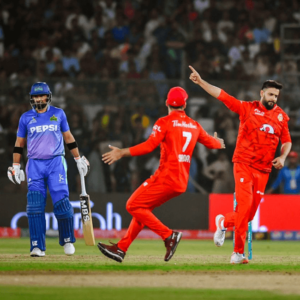
Cricketing Excellence Unveiled: The Story of Babar Azam and Usman Khan in PSL 9
This PSL season saw many batters play their part in the batting department for their teams. We saw heroics from Rassie van der Dussen, who averaged 73 with a strike rate of 155 in 7 games and scored 364 runs for Lahore Qalandars. We saw unbelievable shots played by the likes of Reeza Hendricks, who averaged 43 and scored around 304 runs at a strike rate of 135. Additionally, we saw immaculate hitting from Usman Khan, who scored back-to-back centuries and a 90-odd, striking at 164 runs per hundred balls – with 430 runs in a mere seven innings at an astonishing average of 107. Most remarkably, there was the exceptional output of Babar Azam, who was in full flow and piled up 569 runs at an average of 57 and a strike rate of 143.
Let’s delve into the statistics thoroughly and assess each player’s performance relative to the average batters of PSL 9 who have batted in the top 7 batting positions.
We will consider only three attributes of a batter: Total runs scored, total balls faced, and the total outs of batting positions (1-7). The idea is to capture in one single number: the total runs scored by the batter, his strike rate, and the rate at which he gets out.
This single number is called Runs Above Average (RAA). It has two parts, one which captures the strike rate of the batter and the second which captures the rate at which a batter gets out.
The first part is computed for batsmen as follows. In this year’s PSL, the average batter (1-7 positioned) scored 1.3829 runs per ball. Now, consider, If a batter scores 500 runs in 300 balls, he is scoring 500 – 1.38 * 300 runs above average, which is 86 runs.
The second part is computed by looking at the rate at which the batter gets out. In this year, the average batter made 0.050 outs per ball. If the particular batter we discussed above, in addition, made 10 outs in 300 balls, then he made 0.050 * 300 – 10 outs less than the average player over 300 balls, which is 5. The overall average of a PSL 9 (1-7 positioned) batter is 27.61. So overall, he contributed 5 * 27.61 = 138.05 runs more than the average player in terms of getting out. Taking the sum of both parts, this particular batsman made 86 + 138.05 = 224.05 runs above average.
Thus, the formula for computing the runs above average is…
RAA = (Batter runs – Average batting strike rate * Balls faced by Batter ) + Overall batting average * Balls faced by Batter * (Average out rate – Batter’s out rate)
The criteria we’ve selected to explain the concept vary from player to player. We have unique data for each player, which we’ll analyze to determine the most significant factors. Below is the table illustrating the RAA for the top run scorers in this year’s PSL.
Babar Azam has the 2nd most RAA (294) amongst all the batters batting in the top 7 positions in PSL 9. Usman Khan was in first position and ahead of Babar with 320 runs above average than an average (1-7 positioned) batter of PSL. Van der Dussen follows both of these batters at the third position with an RAA value of 227 and Hendricks with an RAA value of 111. Apart from these four batters, no one has the runs above average tally in triple digits, making Usman the only batter to have it in digits of 300s and Babar closely following him. Interestingly, before Qualifier 1, Babar was leading this chart, but those two slow innings in Qualifier 1 and Eliminator 2 cost Babar some impact runs, and in the meantime, Usman, who then had around a 290 RAA value, climbed to the formidable figure of 300.
In Graph 2, a top 10 batters’ runs vs. strike rate graph, we plotted the values for each player in the form of scattered points. Each point is represented by a particular batter, and that, in turn, is shown by a symbol. The size of the symbol indicates the batters’ averages – the greater the average, the bigger the symbol, and vice versa. Usman’s indicator is the largest, which shows his average is the highest in this year’s PSL. RVD follows closely at 2nd position and Babar at 3rd.
When examining the plotted graphs and delineating them into four distinct quadrants with baselines at 450 runs and a 140 strike rate, it becomes evident that only Babar occupies the top right corner. This placement underscores his consistent and rapid accumulation of over 500 runs in the tournament. Unlike other batters with average statistics, Babar stands out as an outlier, positioned on the extreme end of the spectrum.
In conclusion, while several batters have showcased remarkable performances in this year’s PSL, the evaluation of their contributions goes beyond mere runs scored. Through the Runs Above Average (RAA) metric, we’ve delved into the statistical nuances to assess the true impact of each player relative to the average batters in the tournament.
Usman Khan’s exceptional RAA stands out, closely followed by Babar Azam, despite a slight dip in form towards the end. Graphical representations further illustrate the dominance of these players, with Babar’s consistency and rapid run accumulation distinguishing him from the rest. As the tournament progressed, it’s evident that performances go beyond surface-level statistics, highlighting the significance of deeper analytical insights in cricket evaluation.
The opinions expressed solely belong to the writer and do not necessarily reflect the views of Grassroots Cricket.









Leave a Reply